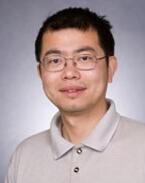 题目:Orbital-active honeycomb materials
题目:Orbital-active honeycomb materials
报告人:吴从军 教授
University of California, San Diego
时间:2019年7月4日(星期四)下午14:30
地点:国家脉冲强磁场科学中心B206
报告摘要:
We provide a unified view for a class of orbital-active honeycomb materials, including bis-muthene, stanene, exciton-polarition lattice, and the recent focus of the twisted bilayer graphene. These materials are orbital-active possessing a pair of degenerate px and py orbitals on each site, which are unified under the E-representation of the C6v group symmetry. We started the research on orbital-active honeycomb systems in ultra-cold atom optical lattices, and found that similar physics also applies to the above solid state materials unified under the same symmetry structure. For solid state applications, we propose a new mechanism to boost the topological gap to the full scale of the atomic spin-orbit coupling, i.e., the order of 1eV. This mechanism has been recently realized in experiments of bismuthene on SiC, which shows the evidence of the gap up to 0.67eV. Mech-anism for unconventional superconductivity assisted by the orbital structure in this class of mate-rials is also studied. The flat band structure arises in 2D orbital-active honeycomb materials, such as organic metal frameworks and transition metal oxide films, in which strong correlation phe-nomena including Wigner crystallization and ferromagnetism appear.
参考文献:
1. Gu-Feng Zhang, Yi Li, Congjun Wu, “The honeycomb lattice with multi-orbital structure: topo-logical and quantum anomalous Hall insulators with large gaps, Phys. Rev. B 90, 075114 (2014)”.
2. Congjun Wu, “Orbital analogue of quantum anomalous Hall effect in $p$-band systems”, Phys. Rev. Lett. 101, 186807 (2008).
3. Congjun Wu, Doron Bergman, Leon Balents, and S. Das Sarma, "Flat bands and Wigner crystal-lization in the honeycomb optical lattice", Phys. Rev. Lett. 99, 70401 (2007).
4. G. Li, W. Hanke, E. M. Hankiewicz, F. Reis, J. Schaefer, R. Claessen, Congjun Wu , Ronny Thomale,“A new paradigm for the quantum spin Hall effect at high temperatures” , Phys. Rev. B 98, 165146 (2018).
5. Yuanping Chen, Shenglong Xu, Yuee Xie, Chengyong Zhong, Congjun Wu, Sheng-bai Zhang, “Ferromagnetism and Wigner crystallization in Kagome graphene and its relatives” Phys. Rev. B 98, 035135 (2018).
报告人简介:
Congjun Wu received his Ph.D. in physics from Stanford University in 2005, and did his post-doctoral research at the Kavli Institute for Theoretical Physics, University of California, Santa Barbara, from 2005 to 2007. He became an Assistant Professor in the Department of Physics at the University of California, San Diego (UCSD) in 2007, an Associate Professor at UCSD in 2011, and a Professor at UCSD in 2017. His research interests include quantum dynamics, quan-tum magnetism, superconductivity, orbital physics, and topological states in condensed-matter and cold-atom systems. He was awarded an APS fellowship nominated by the Division of Con-densed Matter Physics in 2018, an AFOSR Young Investigator Award in 2011, a Sloan Research Fellowship in 2008, and an Outstanding Young Researcher Award from Overseas Chinese Phys-ics Society in 2008.